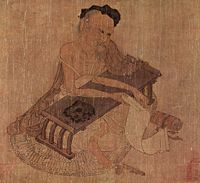Wang Wei (eighth century poet)
- This article is about the 8th century Chinese poet; for other people whose names are rendered "Wang Wei" when romanized, see Wang Wei (disambiguation).
- This is a Chinese name; the family name is 王 (Wang).
 | |
| Born: | 701 |
|---|---|
| Died: | 761 |
| Occupation(s): | Poet, Painter, Chancellor |
Wang Wei (Traditional Chinese: 王維; Simplified Chinese: 王维; pinyin: Wáng Wéi, 701–761), sometimes titled the Poet Buddha, was a Tang Dynasty Chinese poet, musician, painter and statesman.
From a high family, he passed the civil service entrance examination in 721 and had a successful civil service career, rising to become Chancellor in 758. During the An Lushan Rebellion he avoided actively serving the insurgents during the capital's occupation by pretending to be deaf.
He spent ten years studying with Chán master Daoguang. After his wife's death in 730, he did not remarry and established a monastery on part of his estate.
He is best known for his quatrains depicting quiet scenes of water and mist, with few details and little human presence. The Indiana Companion comments that he affirms the world's beauty, while questioning its ultimate reality. It also draws a comparison between the deceptive simplicity of his works and the Chan path to enlightenment, which is built on careful preparation but is achieved without conscious effort.
None of his original paintings survive, but copies of works attributed to him are also landscapes with similar qualities. He influenced what became known as the Southern school of Chinese landscape art, which was characterised by strong brushstrokes contrasted with light ink washes.
Wang Wei's most famous poetry, such as the poem "Deer Park," form a group titled Wang River Collection. They record a poet's journey, ostensibly that of Wang Wei and his close friend, Pei Di. They are far more universal than a simple journey and have inspired generations of poets since, including recent adaptations such as Pain Not Bread's Introduction to the Introduction to Wang Wei (ISBN 1-894078-09-8), Barry Gifford's Replies to Wang Wei (ISBN 0-88739-441-8) and Gary Blankenship's A River Transformed (ISBN 1-4116-6227-X).
Eliot Weinberger and Octavio Paz's 19 Ways of Looking at Wang Wei (ISBN 0-918825-14-8) is an essay concerning more than 19 translations of Wang Wei's "Deer Park."
One of Wang Wei's poems, called Weicheng Qu or "Song of the City of Wei" has been adapted to the famous music melody, Yangguan Sandie or "Three Refrains on the Yang Pass." The most famous version of this melody is that of the guqin, which Wang Wei probably played.
Poetry sample
- 《竹里館》 "Hut in the Bamboos"
- "Sitting alone, in the hush of the bamboo;
- I thrum my zither, and whistle lingering notes.
- In the secrecy of the wood, no one can hear;
- Only the clear moon, comes to shine on me."
ReferencesISBN links support NWE through referral fees
- Wang Wei:Poems, translated with an introduction by G W Robinson.Penguin Books, Harmondsworth 1973
- The Poetry of Wang Wei,New translations and Commentary, Pauline Yu. Indiana University Press 1980-extensive comments ,with Chinese texts.
- Nienhauser, William H (ed.). The Indiana Companion to Traditional Chinese Literature. Indiana University Press 1986. ISBN 0-253-32983-3
External links
- Open Directory Project category
- Regulated verses of Wang Wei, with English translation, pinyin transliteration, and tonal patterns.
- Translations by sixteen poets of "Deer Park"
- a fabulous poem of Wang Wei in Manipuri, translated by Konthoujam Suranjit
| Preceded by: Li Lun |
Chancellor of China 758–759 |
Succeeded by: Diwu Qi |
| Persondata | |
|---|---|
| NAME | Wei, Wang |
| ALTERNATIVE NAMES | Wáng Wéi; 王維 (Traditional Chinese) |
| SHORT DESCRIPTION | Chinese poet, painter |
| DATE OF BIRTH | 701 |
| PLACE OF BIRTH | |
| DATE OF DEATH | 761 |
| PLACE OF DEATH | |
zh-classical:王維
Credits
New World Encyclopedia writers and editors rewrote and completed the Wikipedia article in accordance with New World Encyclopedia standards. This article abides by terms of the Creative Commons CC-by-sa 3.0 License (CC-by-sa), which may be used and disseminated with proper attribution. Credit is due under the terms of this license that can reference both the New World Encyclopedia contributors and the selfless volunteer contributors of the Wikimedia Foundation. To cite this article click here for a list of acceptable citing formats.The history of earlier contributions by wikipedians is accessible to researchers here:
The history of this article since it was imported to New World Encyclopedia:
Note: Some restrictions may apply to use of individual images which are separately licensed.